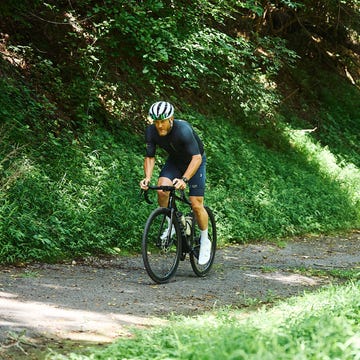If we asked you what the most important muscle is for stronger cycling, the quads, hamstrings, or even calves might come to mind. After all, your legs do a big share of the labor during every pedal stroke.
But what if we told you your legs shouldn’t be getting all the glory? In fact, one of the most important muscles for any cyclist is one that most of us never even think about, let alone train. The key to unlocking faster cycling may be a muscle that many of us completely take for granted.
The muscle we’re talking about is the diaphragm, a dome-shaped muscle that sits below the lungs and is our primary respiratory muscle.
When the diaphragm activates as we inhale, the dome flattens and descends, which expands the rib cage and the chest cavity, allowing the lungs to expand and fill with air. As we exhale, the diaphragm returns to the dome shape, as the rib cage contracts and our lungs deflate. This happens thousands of times a day—which is why it’s important to optimize the action and to do that, you need some diaphragm release.
Why the Diaphragm Is So Important in Cycling
You’d think that breathing in a way that optimally uses our diaphragm is something our body just does automatically, but it turns out that’s not the case. Many of us have lost the ability to take full, complete inhales and exhales—which happens when you breathe diaphragmatically—and the reality is we’re using only a fraction of our lung capacity.
“Most people aren’t fully using the diaphragm and are breathing with their shoulders instead, starting their breath from their chest instead of their stomach,” Matt Conroy, D.C., chiropractor based in Easton, Pennsylvania, tells Bicycling.
The diaphragm isn’t only important for breathing, though. An underperforming diaphragm can also have adverse effects on our posture and low spine stability. Preliminary research also suggests diaphragm function even affects our balance.
Our ability to breathe while properly engaging our diaphragm also affects our stress levels. Diaphragmatic breathing lowers not just the psychological markers of stress, but also the physiological ones. One systematic review of research found that diaphragmatic breathing lowers cortisol and blood pressure.
Just like any other muscle in the body, the diaphragm can also get “tight.” “Any kind of tightness in the diaphragm can limit the amount of breath we take,” Conroy says. “And it can also lead to tightness in the back or vice versa—tightness in our back and posture can affect our respiratory capacity.”
This is why you need to stretch and release the diaphragm regularly as part of your mobility and stretching routine. It will help your diaphragm to function optimally, which will help you breathe better. And being able to fully inhale and take in as much oxygen as possible has a direct, positive effect on our athletic performance, both on and off the bike.
Common Causes of Diaphragm Dysfunction
When it comes to the exact reasons a respiratory muscle, like the diaphragm, gets tight in the first place is a bit of a chicken or egg scenario. Poor posture can be both a cause and an effect of a tight diaphragm.
“If we have poor posture, our diaphragm has to work harder in order to take a deep breath,” says Conroy “Whereas if we have better posture, our diaphragm probably can work a little more efficiently.” That goes for posture in life, as well as posture on the bike.
The reason posture plays such a big role in our diaphragm function is because slouching or riding a bike in a hunched-over position can lead to a tight back. The area of our back that, if tight, has the biggest impact on the diaphragm is where the upper back meets the lower back, just below your ribcage, according to Conroy.
“That area is super central in our body,” he explains. “Our lats attach down into that area. So even tightness into that mid to lower back area can affect the way our diaphragm functions and can also affect the way our arms are moving, and how our core functions. It’s all connected.”
Another area of our body that can cause a tight diaphragm is less obvious and even a little surprising: the neck. The nerve that stimulates the diaphragm, called the phrenic nerve, doesn’t actually originate in the back, but rather from the neck, Conroy explains. “So the nerve that tells the diaphragm to move, the motor control, comes out of the neck. So even something like a pinched nerve in the neck can affect your diaphragm’s ability to function,” he says.
Our mind and mindset can play just as big a role in diaphragm function as other muscles. “I think some of it is psychological, a result of holding our stress and our breath without realizing it. [The diaphragm is] an emotional organ. We hold our grief there. We hold sadness. We hold anxiety,” Jessica Stefano, LMT, owner of Kneaded Soul Therapy in Easton, Pennsylvania, tells Bicycling. “So when it is not fully functioning, or we’re not using it to its potential, it causes chest pains, it causes our chest cavity to tighten up, we get trigger points that shoot to the sternum.”
To avoid the side effects of a tight diaphragm, including back or chest pain, here’s how to tune into whether you’re breathing using your diaphragm, and how to get release for a tight diaphragm.
The Best Exercises for Diaphragm Release
Below we have two exercises that will teach you how to train your breathing so you fully engage your diaphragm, plus three ways you can stretch and release a tight diaphragm.
Conroy suggests performing the moves below regularly as part of your mobility and riding routine, aiming to perform the exercises three times a week, if not daily.
Step One: Dial in Your Diaphragmatic Breathing
Diaphragmatic Breathing Drill, Part One
This can take some time to master if it’s new to you, so don’t get discouraged if it takes a little while for the body to figure it out. It will become second nature with time.
- Start seated or standing.
- Place one hand on the chest and the other on the belly.
- Take a deep inhale while expanding the belly and keeping the chest and shoulders still. The hand on the chest shouldn’t expand, only the belly.
- Practice this for a few minutes several times a day.
Diaphragmatic Breathing Drill, Part Two
- Start either seated or standing.
- Using a hand towel, wrap it around the rib cage holding on to each end with the hands, palms facing up.
- Inhale and expand the ribcage, pressing the ribs against the towel, which will provide direct tactile feedback of whether or not the rib cage is expanding 360 degrees.
- Keep the chest still and focus on expanding the rib cage when inhaling.
- Practice this for a few minutes several times a day.
Step Two: Release Trigger Points in Your Diaphragm
Foam Roller Diaphragm Release
- Place a foam roller on the floor in a horizontal position.
- Lie faceup on the foam roller, positioning it just below the lower tip of the shoulder blades. Bend both knees and place feet flat on the floor or keep them extended, whichever is more comfortable.
- Interlace hands, behind head, and inhale deeply while extending back over the roller until the head is resting on the floor.
- Optional: Inhale and curl the head and shoulders back up as though doing a crunch. Sync your inhales and exhales with the movement during this release.
- Repeat several times until you feel a release in the diaphragm and back.
Acumobility Ball Diaphragm Release on a Bench
- Kneeling in front of an exercise bench, place the fingers of each hand under the ribs on the left and right side.
- Lightly press up against the ribs. You may feel muscle tenderness.
- Lining up the acumobility balls in the same place as the fingers, move the hands out of the way and slowly and gently lower the upper body so you’re lying facedown on the bench and on the acumobility balls.
- Take several deep inhales and exhales. This trigger point release can feel intense.
- Repeat the inhale/exhale cycle for 30-60 seconds or until you feel a release.
Pilates Ball 360-Degree Release
- Lie faceup, place a 9-inch Pilates ball under the sternum, approximately 3-4 inches above belly button.
- Slowly lower the upper body over the ball, and place forearms on floor.
- If it’s comfortable, lower upper body down until forehead is resting on interlaced hands on floor.
- Take 4-5 deep inhales and exhales, focusing on breathing from the belly and keeping the shoulders and chest still.
- Once you feel a release, gently move a few inches side to side or in a circular pattern on the ball while continuing to take deep breaths.
- Repeat for 1-2 minutes or until you feel a release through the diaphragm.

Natascha Grief is Bicycling’s Health & Fitness Editor. She started in the cycling industry as a bike mechanic a couple of decades ago, earning a couple pro-mechanic certifications and her USA Cycling Race Mechanic license. She went on to apprentice for framebuilder Brent Steelman in her hometown of Redwood City, California before spending several years working for both large and not-so-large cycling brands. She then switched gears and industries to earn multiple personal training certifications while honing her skills as a trainer and coach, specializing in functional training, corrective exercise, and body positive personal training. She began contributing regularly to Runner’s World and Bicycling as a freelance writer in 2020, and joined the editorial staff of Bicycling in 2022.




















